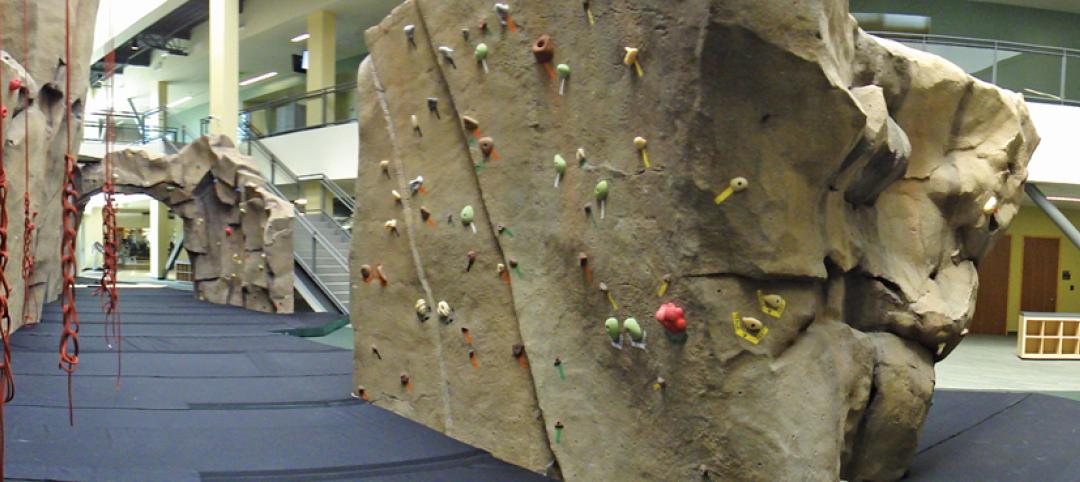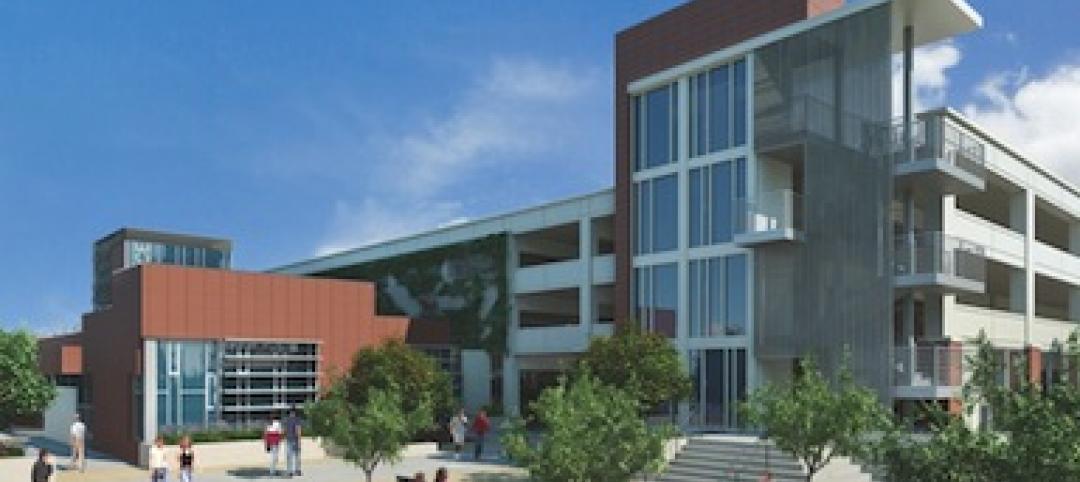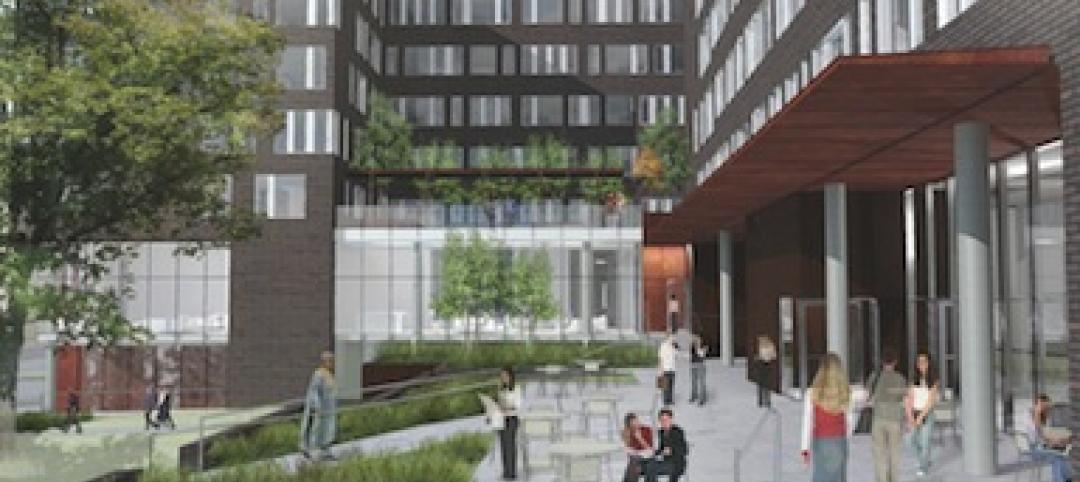 |
|
The new 260,000-sf American Canyon High School campus will serve as many as 2,200 students when it opens for the 2010-11 school year. |
Nestled deep in the Napa Valley, the city of American Canyon is one of a number of new communities in Northern California that have experienced tremendous growth in the last five years. Located 42 miles northeast of San Francisco, American Canyon had a population of just over 9,000 in 2000; by 2008, that figure stood at 15,276, with 28% of the population under age 18. American Canyon's high school-age students, more than 1,200 of them, had to be bussed to neighboring schools in Napa.
By 2006, it was sufficiently clear to the citizens of Napa County that the city needed a new high school of its own. In 2006, voters approved a $183 million school construction bond, $105 million of which was combined with state funds to build a new $121 million high school to accommodate as many as 2,200 students. The Napa Valley Unified School District also stipulated that not only would the school incorporate sustainable strategies where economically feasible, but also that the design should embrace the latest trends in modern schools, notably the concept of having several smaller units within a larger unified campus structure.
Quattrocchi Kwok Architects (QKA) of nearby Santa Rosa was selected to design the proposed American Canyon High School specifically because of its experience designing sustainable K-12 schools. The firm applied the triple bottom line it considers for all its projects—a balancing of economic, environmental, and community impacts—to the design decisions for this project. QKA spent eight months working with the district to write educational and design specifications for the new school.
 |
|
The buildings and pathways of American Canyon High School were designed and oriented to take advantage of sunlight and wind ventilation. The“infinity” pathway that goes past all of the shool’s buildings also gives students and faculty a view of the greater Bay Area past its entrance. |
The school was designed using the guidelines of the Collaborative for High Performance Schools (CHPS), the nation's oldest green building rating program. "We considered the environment in every design decision with the same importance as program and budget. It was an integral part of the design process," said Aaron Jobson, a QKA associate and the project architect.
The 260,000-sf campus, which is currently under construction by Lathrop Construction Associates of Benicia, Calif., will house four "small learning communities" of 500–550 students; these communities will share a central courtyard. Students will have the option to pursue five different "career pathways": visual and performing arts, engineering technologies (such as CAD), global leadership, environmental and health sciences, and arts and hospitality (including culinary arts).
Three of the career pathway classrooms will be shared during off-hours with Napa Valley College, which will offer five-year degrees in technical education. There's also a 2,500-seat gymnasium, an aquatic center, a 400-seat performing arts theater, and outdoor athletic fields. The school is scheduled to open in time for the 2010–11 school year.
 |
 |
|
American Canyon High School’s 400-seat theater building (above) will also be used as a performing arts venue for the community. Its specialized academy buildings (top) will allow students to learn specialized fi elds such as global leadership, environmental and health sciences, hospitality, engineering technologies (including CAD), and visual and performing arts. |
QKA used the latest site and energy analysis tools in the schematic design of the school, known locally as "AmCan High." ArchiCAD, the Graphisoft building information modeling program, was used to develop each new building's design and digital prototype. The result will be the first CHPS-verified high school in the nation when it's completed in July 2010.
The project is designed to achieve 43 of the 85 possible points, with 32 needed for verification. This includes 18 of 20 available energy points. The school will have a 1 megawatt photovoltaic system, a ground-loop heat pump mechanical system, an overall energy-efficient design, and enhanced energy commissioning in conjunction with utility partner Pacific Gas & Electric.
In the water use category, AmCan High received five out of five design points for features such as reclaimed water used for irrigation and low-flow plumbing fixtures.
 |
 |
|
These renderings are overlayed with actual construction site photos of American Canyon High School today. The structural steel frames of the multiuse building (above) and gymnasium (top) have been completed by the general contractor, Lathrop Construction Associates, Benicia, Calif. |
Thanks to its green design features, AmCan High will receive close to $1 million in additional funding from the state, where CHPS-verified schools can receive 2–11% of their costs from the state for building green. "We made what we believe is a good design and then saw how many points were available for it," said Jobson.
Site Design: Melding BIM with Google Earth
The design team used a variety of IT technologies—Google Earth, SketchUp, Ecotect Analysis, and ArchiCAD—to create presentation materials to gain stakeholder support throughout the design and approval processes.
Views of the nearby hills and across the Bay to local landmark Mount Tamalpais are prominent features of the 50-acre site on the eastern edge of the city of American Canyon. QKA's team wanted the buildings and site features to frame those views and connect the campus to the larger Bay Area. Early BIM concept models designed in ArchiCAD were exported to Google Earth using the Google Earth Add-on for ArchiCAD. The direct import-export connection between the programs allowed the architects to study several different conceptual building orientation and siting options.
 |
 |
|
The design team for American Canyon High School used a Graphisoft ArchiCAD BIM model for clash detection and building performance testing. The model sections show one of the school’s lab buildings with walls (above) and without walls (top). Google Earth and SketchUp were also used. |
In Google Earth, the design was displayed in a dynamic 3D environment which showed topography and aerial views of the surrounding landscape, enabling the architects to see how their site design framed views of the campus.
Google Earth was also utilized to affirm sight lines between the campus buildings, which are organized around an elliptical path centering on the school's library and administration building. This allowed for prominent views to the southeast and southwest (with views to the Bay) from the campus green and plaza.
Sun shading design in Ecotect Analysis
The BIM model used for AmCan High had its greatest impact on the project's daylighting component. Most of the school will be naturally lit during the day, and all classrooms will be virtually 100% lit by daylight. To help inform the daylighting design, the ArchiCAD model was imported into the analysis program Ecotect, which can predict building performance for air movement, acoustics, shading, thermal performance, and daylighting.
The Building Team analyzed how sunlight would reflect off the exterior sunshades of the building and disperse into the classrooms and other spaces. Through Ecotect's sun ray diagrams, the light profile could be easily adjusted for different times of the day for any day of the year.
 |
 |
 |
|
Designer Aaron Jobson used Ecotect to analyze daylighting factors in building interiors and to confi gure exterior sun shades. Ecotect Solar Tool, an add-on for shading analysis, was used to create quick models of windows. |
Ecotect can also analyze the amount of daylight in a room and calculate an average for the entire year. That analysis grid was configured to conform to CHPS standards for light levels and daylight factor three feet from the walls and on a solar plane 30 inches above the floor. Ecotect produced a graph showing the average light level in foot candles and daylight factor. After what-iffing a number of window and sunshade conditions and graphing them in Ecotect, the architects settled on a design that represented the optimal distribution of daylight, one in which the exterior sunshades will block direct sunlight from the classrooms, minimizing solar heat gain and glare. The resulting window design also created opportunities for natural cross ventilation in the classrooms.
"Through a combination of the orientation of the site (and the design of the sunshades and windows) we were able to keep out most of the direct sunlight and allow in the indirect light that would effectively light all the classrooms," Jobson said.
QKA also used Ecotect analysis to configure the exterior sun shades. From early in schematic design, QKA planned on exterior sunshades for all south-facing windows to control heat buildup, as well as those on the east and west elevations to control glare. Ecotect Solar Tool—a separate add-on used to analyze shading—was used to create quick models of all the windows in question. QKA evaluated the performance of hundreds of different sunshade combinations using the Ecotect Solar Tool, always careful to balance performance with cost, maintenance, and aesthetics in the final configuration of the sunshades.
Assuring Efficient Energy Systems
 |
|
The BIM model of AmCan High aided in the erection of steel members for the project. BIM was used as a tool to guide decision making, not replace the design process, says QKA’s Aaron Jobson. |
QKA took a similar approach to the mechanical systems of AmCan High. Overall the energy systems of AmCan High will deliver 10–20% savings over California's already stringent Title 24 energy code. Some of those savings will come from a ground-loop heat pump system that will heat the school in the winter. Lathrop Construction drilled 285 holes 300 feet deep to enable the ground-loop system to draw heat and cooling from underground water supplies. Displacement ventilation systems were designed for both the 400-seat theater and the library. Displacement ventilation and the ground-loop heat pump system also led to improved acoustics as a result of quieter mechanical systems in the classrooms, enabling the project to achieve three points for acoustics from CHPS.
The biggest clean energy producer for AmCan High will be its photovoltaic system, which will generate 55% of the school's electricity needs (based on Title 24). Three types of PVs will be used: traditional glass-faced crystal panels are being built on flat and sloped-roof areas of the campus buildings and on a large array on a nearby hillside; thin-film PVs are being directly adhered to a standing-seam metal roof over the classrooms; and PV glass panels—solar cells mounted between two panes of insulated glass curtain wall—are being installed around the entries to the campus to provide a visual statement to students and the public that PVs are an important component of the school's energy system. The PV glass also helps shade the entrances.
California's net-metering law requires utilities, in most cases, to offer net metering to all customers for solar and wind-energy systems up to 1 MW in capacity.
Through its ability to generate electricity with its PVs, AmCan High will be able to "zero out" its energy bill for the year by putting as much energy back into PG&E's grid as it uses in the first few years, as enrollment ramps up.
"Everything the BIM model gave us provided quantitative analysis of different scenarios to help us make design decisions," Jobson said. "It's a tool that helps you inform design. That's how we used the modeling and animations we did for AmCan High, as tools to guide decision making. They didn't replace or drive the design process; rather, they informed it."
Related Stories
| Sep 22, 2010
Satellier, Potential + Semac close investment deal
Satellier, a world leader in providing CAD and Building Information Modeling (BIM) outsourced services to the architecture, engineering and construction industry, announces a strategic minority investment from India-based top engineering firm Potential + Semac, ushering in the next evolution of the global architecture support industry.
| Sep 21, 2010
New BOMA-Kingsley Report Shows Compression in Utilities and Total Operating Expenses
A new report from the Building Owners and Managers Association (BOMA) International and Kingsley Associates shows that property professionals are trimming building operating expenses to stay competitive in today’s challenging marketplace. The report, which analyzes data from BOMA International’s 2010 Experience Exchange Report® (EER), revealed a $0.09 (1.1 percent) decrease in total operating expenses for U.S. private-sector buildings during 2009.
| Sep 21, 2010
Forecast: Existing buildings to earn 50% of green building certifications
A new report from Pike Research forecasts that by 2020, nearly half the green building certifications will be for existing buildings—accounting for 25 billion sf. The study, “Green Building Certification Programs,” analyzed current market and regulatory conditions related to green building certification programs, and found that green building remain robust during the recession and that certifications for existing buildings are an increasing area of focus.
| Sep 21, 2010
Middough Inc. Celebrates its 60th Anniversary
Middough Inc., a top ranking U.S. architectural, engineering and management services company, announces the celebration of its 60th anniversary, says President and CEO, Ronald R. Ledin, PE.
| Sep 16, 2010
Gehry’s Santa Monica Place gets a wave of changes
Omniplan, in association with Jerde Partnership, created an updated design for Santa Monica Place, a shopping mall designed by Frank Gehry in 1980.
| Sep 16, 2010
Green recreation/wellness center targets physical, environmental health
The 151,000-sf recreation and wellness center at California State University’s Sacramento campus, called the WELL (for “wellness, education, leisure, lifestyle”), has a fitness center, café, indoor track, gymnasium, racquetball courts, educational and counseling space, the largest rock climbing wall in the CSU system.
| Sep 13, 2010
Community college police, parking structure targets LEED Platinum
The San Diego Community College District's $1.555 billion construction program continues with groundbreaking for a 6,000-sf police substation and an 828-space, four-story parking structure at San Diego Miramar College.
| Sep 13, 2010
Campus housing fosters community connection
A 600,000-sf complex on the University of Washington's Seattle campus will include four residence halls for 1,650 students and a 100-seat cafe, 8,000-sf grocery store, and conference center with 200-seat auditorium for both student and community use.










